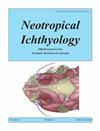The influence of landscape at multiple spatial scales of the river basins at the Eastern Amazon fish assemblage
IF 2
4区 生物学
Q1 ZOOLOGY
引用次数: 0
Abstract
Abstract The Amazon River basins present distinct natural and anthropogenic characteristics that influence the structure of stream habitats and their associated biota. The influence of these characteristics can be evaluated through different spatial scales. We aimed to assess the influence (with and without the effect of spatial-geographical factors) of local, macroscale, and land-use variables in the structure of stream fish assemblages of Amazonian catchments with different deforestation levels. A partial redundancy analysis and a reduced metrics model were used to assess these influences. With geographic-spatial effects, we verified that the macroscale and local variables explained the variation in fish composition, and, without the effects, land use also explained the variation in this composition. In the forested catchments, the biota was associated with streams with natural characteristics (e.g., leaf banks). In the deforested catchments, it was associated with land use, sandy catchments with higher soil density (higher capacity of degradation), and less complex streams (fewer leaf banks, more sand). The associated fish have life features linked to these characteristics (e.g., Gymnorhamphichthys rondoni associated with sand). This configuration seems to be a result of both the impact of land use in the catchment (i.e., increased erosion, increased sedimentation) and the naturally sandy constitution of the catchment as well, reflecting the sandy substrate.河流流域多空间尺度景观对亚马逊东部鱼类群落的影响
亚马逊河流域具有明显的自然和人为特征,这些特征影响着河流生境及其相关生物群的结构。这些特征的影响可以通过不同的空间尺度来评价。我们的目的是评估不同森林砍伐水平的亚马逊流域,当地、宏观尺度和土地利用变量对河流鱼类群落结构的影响(有和没有空间地理因素的影响)。使用部分冗余分析和简化度量模型来评估这些影响。考虑到地理空间效应,我们验证了宏观尺度和局部变量解释了鱼类组成的变化,并且在没有影响的情况下,土地利用也解释了这种组成的变化。在森林流域,生物群与具有自然特征的溪流(如叶岸)有关。在森林砍伐的集水区,它与土地利用、土壤密度较高(退化能力较高)的沙质集水区和不太复杂的溪流(较少的叶堤,更多的沙)有关。相关的鱼类具有与这些特征相关的生命特征(例如,与沙子相关的Gymnorhamphichthys rondoni)。这种结构似乎是集水区土地利用的影响(即,侵蚀增加,沉积增加)和集水区天然砂质构成的结果,也反映了砂质基质。
本文章由计算机程序翻译,如有差异,请以英文原文为准。
求助全文
约1分钟内获得全文
求助全文
来源期刊

Neotropical Ichthyology
生物-动物学
CiteScore
2.80
自引率
17.60%
发文量
24
审稿时长
6-12 weeks
期刊介绍:
Neotropical Ichthyology is the official journal of the Sociedade Brasileira de Ictiologia (SBI). It is an international peer-reviewed Open Access periodical that publishes original articles and reviews exclusively on Neotropical freshwater and marine fishes and constitutes an International Forum to disclose and discuss results of original research on the diversity of marine, estuarine and freshwater Neotropical fishes.
-Frequency: Four issues per year published only online since 2020, using the ‘rolling pass’ system, which posts articles online immediately as soon as they are ready for publication. A searchable and citable Digital Object Identifier (DOI) is assigned to each article immediately after online publication, with no need to await the issue’s closing.
-Areas of interest: Biology, Biochemistry and Physiology, Ecology, Ethology, Genetics and Molecular Biology, Systematics.
-Peer review process: The Editor-in-Chief screens each manuscript submitted to Neotropical Ichthyology to verify whether it is within the journal’s scope and policy, presents original research and follows the journal’s guidelines. After passing through the initial screening, articles are assigned to a Section Editor, who then assigns an Associate Editor to start the single blind review process.
 求助内容:
求助内容: 应助结果提醒方式:
应助结果提醒方式:


